
|
|

I
took over this e-zine when Gail, its originator was unable to continue it. With
Gail's permission, I have added her original Rock's of the Week so that everyone
can find the information readily. Please feel free to visit Gail's web site at http://www.davesrockshop.com. |
|
Smoky Quartz
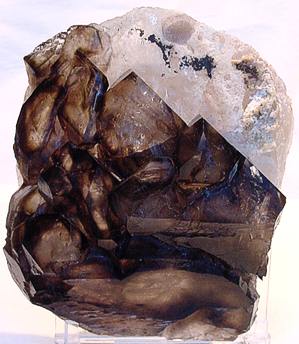
Smoky Quartz from Galileia Minas Gerais, Brazil
|
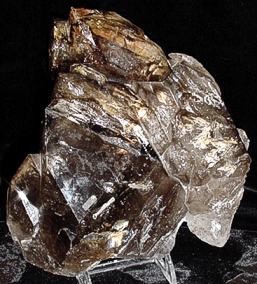
Smoky Quartz Elestial from Brazil
|
|
Scientific:
Smoky quartz, the black or brown variety of quartz is named after it's smoky color. The name 'quartz' as I have said before, comes from the Slavic word for 'hard'. Smoky quartz is a popular variety of quartz. It has an unusual color for a gemstone and is easily recognized and is well known by the general public. Only a few other brown or black minerals are ever cut for gemstones such as the smoky topaz, the very rare black beryl or the brown corundum. |
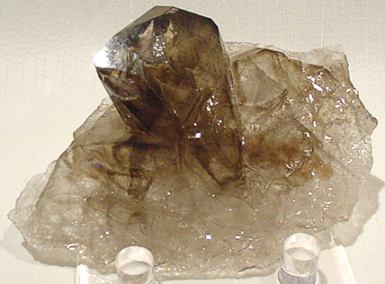
Elestial Smoky Quartz
Location: Barra do Salinas, Minas Gerais Brazil
|
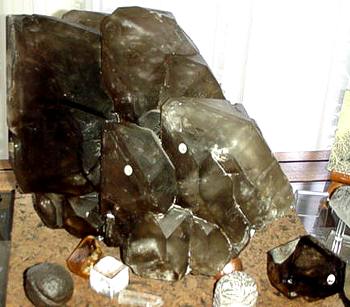
Smoky Quartz photo courtesy of a private collector
|
|
Smoky quartz has a few varieties of its own:
Cairngorm is a variety that comes from the Cairngorm Mountains in Scotland. They tend to be yellow-brown and
gray-brown.
Morion is a very dark black opaque variety of smoky quartz. (Morion is also the name of a type of helm used in the 16th and 17th centuries.) 'Morion' may come from the Greek word for baneful or hideous.
Coon tail quartz is a smoky quartz with an alternating black and gray banding.
|
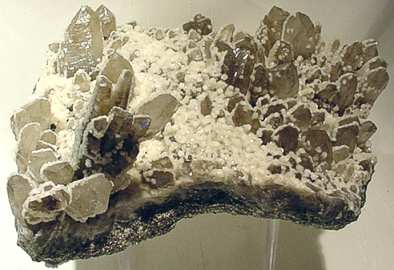
Smoky quartz, barite, and pyrite
Location: Romania
|
|
The color of smoky quartz is variable from brown to black and sometimes smoky gray colored specimens are included as smoky quartz. The very dark stones are called Morion and Cairngorm. The cause of the color of smoky quartz is in question but it is almost certainly related to the amount of exposure to radiation that the stone has undergone. Natural smoky quartz often occurs in granitic rocks that have a small but persistent amount of radioactivity. Natural Smoke Quartz crystals are also a product of irradiation, but by nature in it's own very slow processes. It occurs as nodules or fillings of clefts in serpentine rocks and in weathered materials of nickel ore deposits. Most smoky quartz that makes its way to rock shops and to some gem cutters has been artificially irradiated to produce a dark black color. Much of the smoky quartz on the market is in fact irradiated rock crystal. Brown quartz has been confused with andalusite, axinite,
idocrase, and brown tourmaline. |
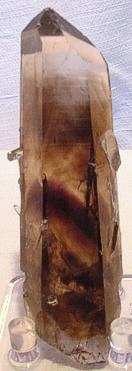
Phantom Smoky Quartz Location: Lincoln County, New Mexico
|
|
Natural Smoky Quartz tends to be smoky to the base, whereas irradiated tends to have a white crystal base next to the matrix rock. Also if it is so black you cannot see through it and it has good surface luster, it is probably irradiated.
Long ago, the deposit of Frankenstein (Zabkowice) in Upper Silesia, Poland, was the most important mine, but it has been worked out since the 14th century. Today's deposits include Australia (New South Wales), Brazil, India, Kazakhstan, Madagascar, Russia (the Urals), Zimbabwe, South Africa, Tanzania, Scotland, Ukraine, Switzerland and California. |
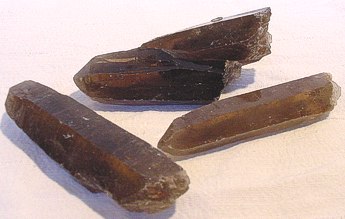
Smokey Quartz Location: Hubei, China
|
|
Smoky quartz sometimes forms with an etched pattern of lines, depressions and raised terminations. If these etched terminations are accompanied by plainly visible internal cavities arranged in geometric patterns related to the quartz crystal structure, the form is referred to as skeletal or 'Elestial' quartz. The internal cavities of skeletal quartz often contain clay minerals of varied colors, sometimes accompanied by carbon dioxide or water. These cavities can have a layered or ribbed aspect and are sometimes so pronounced as to make the crystal almost hollow, giving rise to the term skeletal quartz. Occasionally these cavities contain both liquid and gas phases together known as two-phase inclusions. In rare cases, these two-phase inclusions in skeletal quartz may show actual movement of the gas phase within the liquid phase (popularly known as elestial smoky quartz
'enhydros'). |
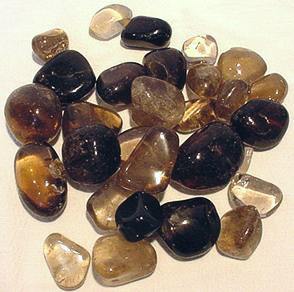
tumbled smoky quartz
|
Many different minerals can form as inclusions within smoky quartz. Some of the more important varieties of included quartz for gem use are rutilated quartz and tourmalinated quartz. Some other common mineral inclusions in smoky quartz are chlorite, goethite and hematite.
Phantom quartz shapes are sometimes present in the interior of smoky quartz crystals, outlining an earlier stage of the crystal's formation. These phantoms are usually composed of other minerals such as chlorite or other varieties of quartz such as milky quartz, colorless rock crystal, or smoky quartz of lighter or darker shades which form on most or all of the surfaces of the quartz crystal at a particular point in time during its growth, after which the quartz crystal resumes its crystallization enclosing the phantom crystal outline within itself. |
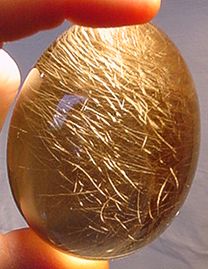
rutilated smoky quartz egg
|
|
If a smoky quartz contains rutilations, it is sometimes called Smoky Sagenite rather than Rutilated Quartz. Smoky quartz has been misleadingly sold as Smoky Topaz. Smoky quartz is now often cooked at high temperatures to produce the more profitable orange yellow Citrine. This process usually creates darker brownish orange stones, which can be confused with the deeper color natural Citrine from Brazil. Radium Diamond is just another name for Smokey Quartz.
Smoky quartz is popular as an ornamental stone and is ed into spheres, pyramids, obelisks, eggs, figurines and ornate statues. There is also a famous smoky quartz crystal skull by the name of "ET". It is a smoky quartz skull found in the early 20th Century in Central America. It was given its nickname because its pointed cranium and exaggerated overbite make it look like the skull of an alien being. ET is part of the private collection of Joke Van
Dietan, who tours with her skulls to share the healing powers she believes they possess. |
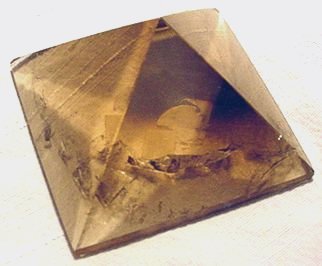
smoky quartz pyramid
|
In Sri Lanka, quartz varieties (smoky, citrine, and rock crystal) are called 'topaz' (in English). The dealers are not intentionally misleading (though such a possibility exists), but to them quartz is English for topaz! To tell the difference between topaz and smoky quartz, run your thumb across the table facet. Practice it! Topaz is very slippery and your thumb slides across the table facet as if it were ice while on quartz the thumb "sticks".
Variety of: Quartz
Hardness: 7
Chemical Composition: SiO2 silicon dioxide |
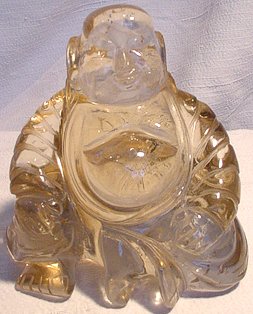
Smoky Quartz Buddha
|
History:
The ancient Romans used smoky quartz to make Intaglio seals.
Smoky Quartz is the national gem of Scotland.
A crystal ball two and a half inches in diameter surmounts the Scottish scepter. The use of such balls has been traced back to the Druids. They were still known as 'stones of power' in Sir Walter Scott's days. Another sphere of smoky quartz, which the Scots called Cairngorm, is now in the possession of the British Museum and is reputed to be the famous
'shew-stone' of Dr. Dee, the court diviner to Queen Elizabeth I of England.
The world's largest cairngorm (crystal), which weighs in at 52lbs, is at Braemar Castle in Scotland. |
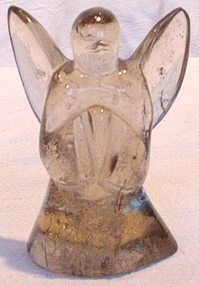
Smoky Quartz Angel
|
The Highland Sgian Dubh:
The words above in Gaelic mean 'dubh' (black) and
'sgian' (dagger). The dagger was so described because the handle was often made of bog oak. A very hard wood, jet-black in appearance, it was useful for the purpose. It is ornamented, which is a reflection of the Highlanders' lack of confidence in paper money. Highlanders would ornament much of their apparel with valuable silver and cairngorm stones. They carried on their person most of their worldly wealth, not entrusting it to banks. The black dagger
(sgian dubh) was invariably carried in a place of concealment, very often under his armpit. This gives support to the view that 'black' does not refer to the color of the handle but implies 'covert' or 'concealed'.
When the Highlander visited a house on his travels, having deposited all his other weapons at the front door, he did not divest himself of his concealed stabbing dagger, since in those days it was unsafe to be ever totally unarmed, not because he feared his host, but rather because he feared intrusions from the outside. Accordingly, although retaining the dagger, out of courtesy to his host, he removed it from its place of concealment and put it somewhere where his host could see it, invariably in his stocking on the right-hand side if he was right handed and on the left-hand side if he was left handed. |
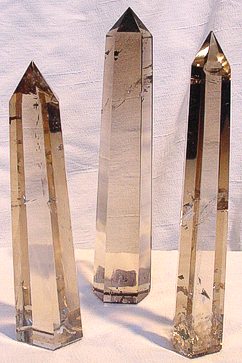
Smoky Quartz obelisks
|
As with all quartz, smoky quartz is an energy conductor and generator. However, because of its smoky color, it is a very grounding stone. Smokey quartz disperses negative patterns and vibrations, and transmits a high quantity of light. It purifies the primal instincts (1st chakra), and helps one get in touch with nature, excellent for meditation and healing on the mental and etheric levels.
Smoky helps to reach the goals sent during psychic dreams, during which it increases awareness and helps to guide spirits in channeling dreams. It transforms escapist attitudes and allows one to let go of what is not needed to allow growth.
It can be used to gently dissolve negative energies and emotional blockages. It can be used to initiate a powerful force field which will absorb many forms of negativity, both from within ones self and from other forces. It promotes personal pride and joy in living. Smoky quartz has been used to regulate creativity in business, and to encourage astute-ness in purchasing. It works to diffuse communication deficiencies and to dissolve mental and emotional blockages that limit perception and learning. |
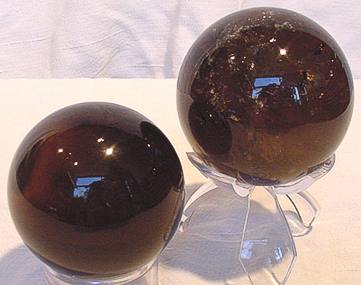
Smoky Quartz spheres
|
|
"Ten Healing Crystals for Men"
Excerpt from: A Guide to Gem and Crystal Therapy
By Karen Ryan, Crystal Energy Therapist
Smokey Quartz for men:
The "Emotional Balancer Crystal" - Smokey Quartz is a very specialized crystal for negative emotional energy. This crystal is excellent for mood swings, aggressive actions, ill temper, and generally nasty thoughts. It grounds all kinds of negative energy. This stone is helpful for burnout, fear of failure, reluctance to take risks, or wanting revenge, as well as for tendencies to over-eat, smoke or drink due to stress. It helps you accept responsibility for yourself, and to broaden your capacity for effective communication by dissolving self-limiting perceptions.
|
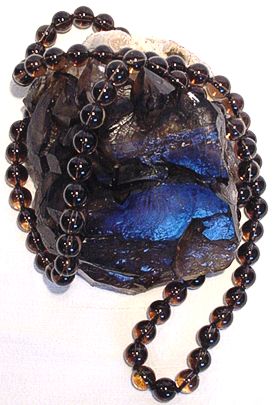
Smoky Quartz beads on smoky quartz
specimen
|
|
Morion quartz, and the dark smoky quartzes, is useful in shadow work, helping the wearer to face the dark aspects of self and to release obstacles. They are grounding and aid in coping with grief. Morion can be used to bring connection with the "darker" faces of the deity, such as the Crone and Hunter archetypes. |
|

















